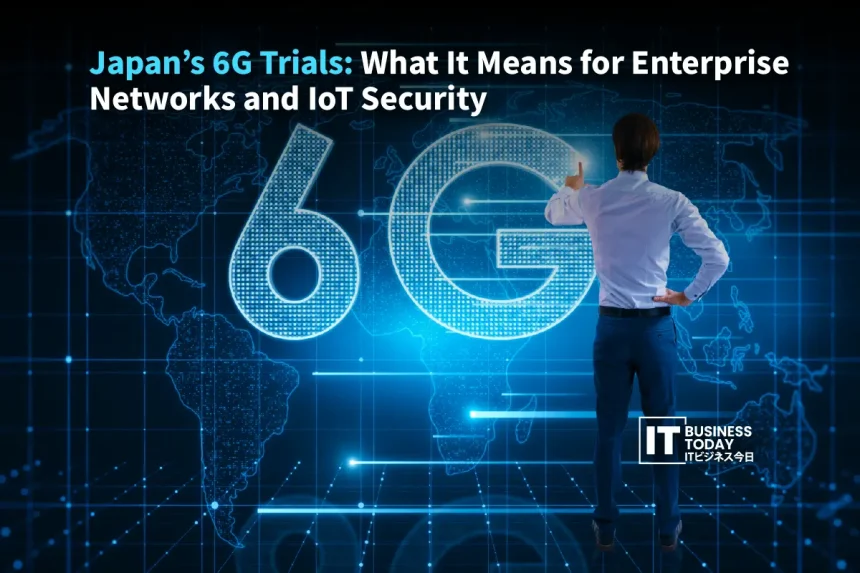The transition from 5G to 6G is not just a matter of speed but rather an entire transformation of the network’s cognitive, connective, and responsive capabilities. 5G provided us with quicker communication, but 6G is targeting the almost immediate interaction of machines, data, and people through real-time intelligence. The overall impact of this alteration will reach far and wide, touching on the topic of industry automation, city operations, and the autonomy of IoT (Internet of Things) devices.
Japan has been the leading country in this technological revolution and so it has assured its place among the most important actors in the movie. The Ministry of Internal Affairs and Communications (MIC) opened the door to the Beyond 5G Promotion Strategy 2.0 in August 2024. The strategy provides a very concrete roadmap for encouraging the next-generation research and infrastructure by means of tight cooperation among the three: government, industry, and academia. NTT, Fujitsu, and SoftBank are among the companies that have already formed a partnership to realize this dream.
Japan’s goal is not just to build faster networks. It is to create a system that is intelligent, reliable, and secure from the very beginning.
Also Read: Global Metaverse-Ready Customer Engagement: How Innovations Are Transforming Brand Experiences
Understanding Japan’s 6G Trial Focus
Japan’s 6G trials aren’t just faster versions of 5G. They’re a full rethink of how networks sense, react, and connect everything. The focus is clear: build a system that moves from milliseconds to microseconds, where machines don’t wait for instructions but respond instantly. Japan’s research teams are chasing latency below one microsecond, the kind of responsiveness that makes autonomous robots, smart factories, and connected vehicles behave like living systems rather than programmed ones.
Another pillar of these trials is the use of the terahertz spectrum, those ultra-high frequencies that can move massive volumes of data almost in real time. It’s not just about speed, though. It’s about enabling immersive environments such as industrial digital twins that mirror physical systems second by second and extended reality training platforms that react without lag.
Then there’s ISAC, or Integrated Sensing and Communication, where the network itself becomes a sensor. Picture a city grid that not only transmits data but also maps its surroundings, tracks movements, and supports disaster response with pinpoint accuracy. NTT, Fujitsu, and SoftBank, the major players in Japan, are doing just that, testing networks that don’t merely connect but can even sense their environment.
The combination of these advances indicates that Japan, without much noise, is showing what 6G should be like: smart, super-responsive, and conscious of its surroundings. Whereas a lot of the world is still arguing over 6G’s speed, Japan has already gone on to the next step, developing a network that operates with the human-like capabilities of thinking, sensing, and acting in real time.
Impact on Enterprise Networks and the Transformation Ahead

Japan’s enterprise networks are in the middle of a quiet revolution. The 6G trials aren’t just testing faster speeds, they’re rewriting how industries operate. The goal is simple yet bold: build networks so intelligent and responsive that machines, systems, and data move as one synchronized organism.
Hyper-automation sits at the core of this shift. With ultra-low latency, Japan’s trials are creating a world where industrial robots and digital twins work in complete lockstep. Imagine a factory where a physical robot arm and its virtual twin mirror each other in real time, adjusting instantly to a single sensor change. That’s not a futuristic idea anymore. It’s a glimpse into what Japan’s engineers are already perfecting, where production lines can self-correct, optimize, and evolve without human delay.
Another major leap is the evolution of Network-as-a-Service. Through advanced network slicing, enterprises can now carve out dedicated, secure, and high-performance lanes within the same infrastructure. This means critical operations like autonomous manufacturing or financial trading can run on slices that guarantee performance and data integrity. The shift takes networks from being static utilities to dynamic business platforms that adapt to real-time demand.
On March 3, 2025, NTT and NTT DOCOMO proved what’s next with their successful demonstration of an ‘In-Network Computing (INC)’ architecture designed for the 6G era. By integrating mobile network and service control, they showcased how enterprises can access on-demand, low-latency bandwidth precisely when and where they need it.
And it’s not just theory. On July 8, 2025, SoftBank announced the installation of three 7 GHz-compatible base stations in central Tokyo, working with Nokia to trial massive MIMO technology for centimeter-wave bands being considered for 6G. This expansion pushes the limits of coverage, capacity, and responsiveness.
Together, these breakthroughs are redefining what enterprise connectivity means. From hyper-automated factories to seamless global logistics powered by non-terrestrial networks, Japan’s 6G trials are building the nervous system for the next industrial era, one that’s fast, adaptive, and globally aware.
The Crucial Challenge of IoT Security in the 6G Era
The promise of 6G comes with a serious reality check. The explosion of connected devices means an equally massive expansion of the attack surface. In Japan’s 6G ecosystem, where millions of IoT sensors, robots, and vehicles will interact simultaneously, every edge device becomes a potential target. These micro endpoints often lack robust protection, making them the weakest link in a hyper-connected chain. The more interconnected the system gets, the harder it becomes to monitor, isolate, and contain a breach in real time.
Quantum computing only raises the stakes further. Japan is already moving ahead of the curve. On September 16, 2025, NICT announced the world’s first integrated system for Quantum Key Distribution (QKD) and high-speed data transmission within a large-capacity optical environment for the IOWN Open APN. This is not just a lab success. It’s Japan building the cryptographic backbone to resist quantum-level cyberattacks that could render today’s encryption obsolete.
Then comes the challenge of Integrated Sensing and Communication, or ISAC. In this model, the network doesn’t just carry data, it perceives its surroundings, constantly collecting non-communication information like motion or environmental conditions. That’s powerful for disaster response and smart city management but also opens up new privacy and data integrity risks. If compromised, the same network that tracks hazards could be used to track people.
The final piece of the puzzle is the AI layer. Japan’s 6G networks are being designed with AI-native control, meaning machine learning will manage traffic, detect anomalies, and optimize resources in real time. But when AI governs the network, it also becomes a new target. Threats like model poisoning or adversarial attacks could manipulate how the system perceives and responds, turning automation into vulnerability.
The takeaway is clear. Japan’s 6G journey isn’t just about achieving faster, smarter networks. It’s about embedding trust at every layer. From post-quantum cryptography to AI-driven defense systems, the next generation of connectivity will only succeed if it’s secure by design, not as an afterthought.
Preparing the Enterprise for a Forward-Looking 6G Strategy
Enterprises can’t wait for 6G to fully arrive before rethinking how they protect their networks. The change ahead is not just technical, it’s a complete mindset shift. As systems become more connected and adaptive, the old idea of securing a single network boundary stops working. What takes its place is Zero Trust, a simple principle that nothing and no one should be trusted automatically. For 6G, this becomes essential because data will constantly move between vendors, clouds, and regions.
Still, Zero Trust alone isn’t enough. The speed and scale of 6G demand that security keeps up in real time. That’s where Security-As-Code plays a major role. By baking automated policies into the system itself, enterprises can detect and respond to risks instantly instead of relying on manual checks. It allows governance to evolve with the network as new devices and services come online every second.
Then there’s the human factor. With 6G introducing post-quantum cryptography, terahertz systems, and AI-driven defenses, the talent gap is widening quickly. Businesses will need teams that understand both digital and operational systems. Developing new skills in PQC, THz security, and AI-based threat analysis will be critical.
Preparing for 6G isn’t about adding new layers of defense, it’s about building smarter ones. The enterprises that stay ahead will be those that treat security as a living system, adaptive, automated, and always one step ahead of the threat.
The Future is Interconnected and Secured by Design

The future that Japan is creating with its 6G experiments is one where everything is connected in a seamless and secure way. The potential is immense, among which real-time automation and more intelligent global interconnectivity are the biggest, but so are the difficulties. Every gain in speed and intelligence brings a new layer of risk. That’s why Japan’s strategy is to build security into the system itself, not bolt it on later.
The ITU-R SG5 WP5D 49th session in Kobe, Japan in mid-2025 was the event where this vision was vividly expressed. The talks determined the technical performance and frequency ranges of the future mobile systems, establishing a truly worldwide 6G infrastructure at the same time. Japan is not only participating in the dialogue but also subtly directing it.
Eventually, the 6G technology will mean more than speedier networks and more intelligent devices. It’s about creating systems that people can trust. Japan’s trials show that the next era of connectivity will only thrive if it’s built to be secure from the ground up.







